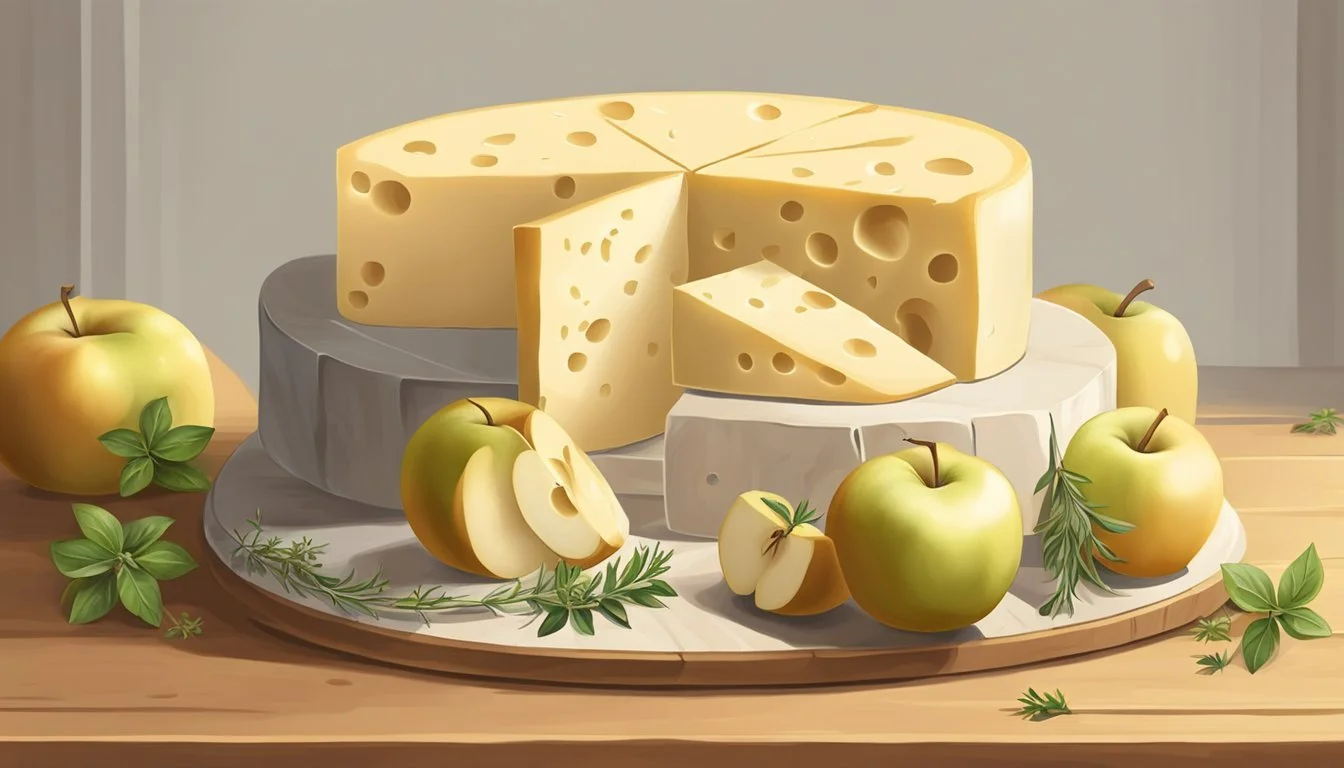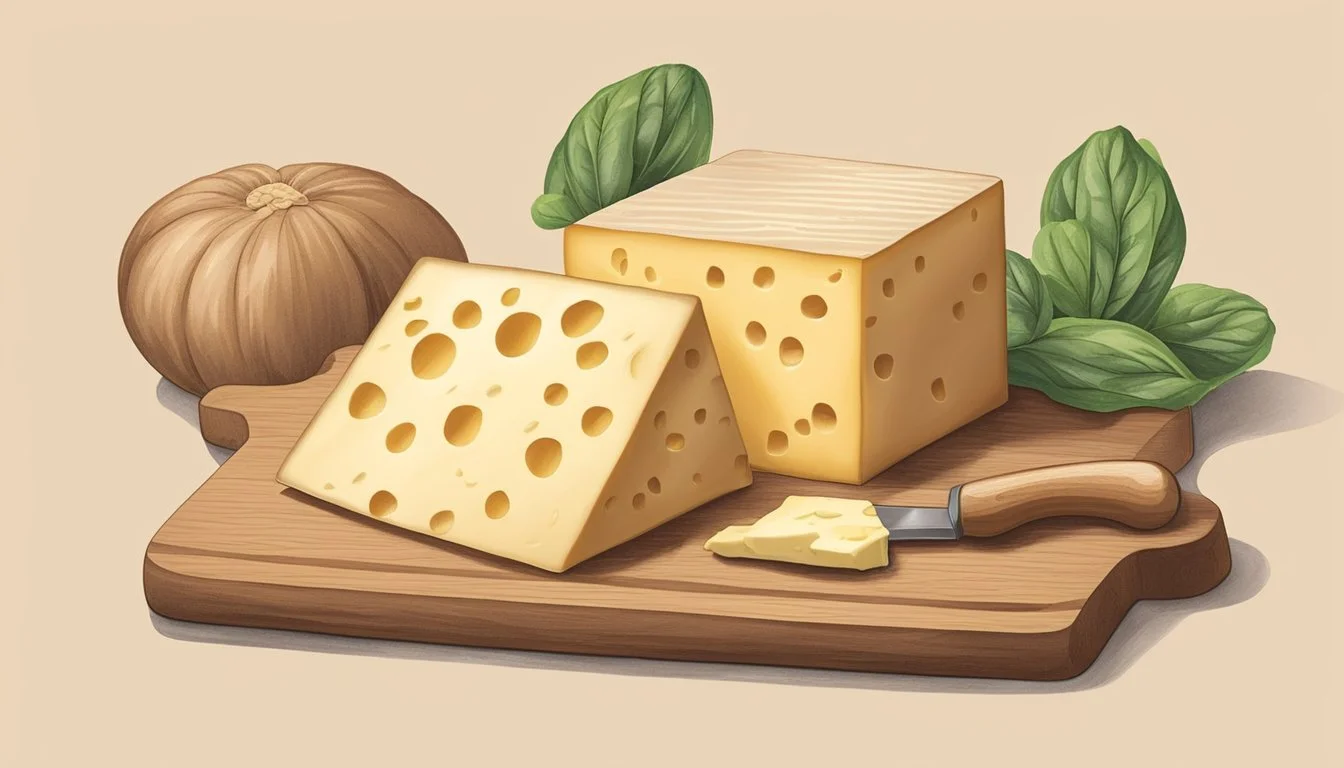Gruyere Cheese Substitutes
Top Alternatives for Your Recipes
Gruyère cheese (What wine goes well with cheese?), a staple in Swiss cuisine, is renowned for its rich, creamy texture and distinctive flavor profile which includes nutty and slightly sweet notes. Originating from the town of Gruyères in Switzerland, this cheese is versatile in its uses, finding its way into dishes like fondue, quiche, and French onion soup, as well as being a beloved topping for various baked dishes due to its excellent melting qualities.
However, certain situations may arise where Gruyère cheese isn't readily available or suitable for specific dietary preferences. In such cases, finding a substitute for Gruyère cheese requires identifying cheeses with similar characteristics, such as a comparable flavor, texture, and ability to melt smoothly. Some of the viable alternatives include Fontina, Emmental, and certain Greek cheeses like Graviera, each offering a balance of richness and flavor that can closely mimic the qualities of Gruyère in various recipes.
When selecting a substitute, it is important to consider the desired outcome in terms of taste and texture since the unique attributes of Gruyère cheese play a pivotal role in the success of many dishes. A well-chosen replacement can ensure that the essence of the original dish is maintained, even in the absence of traditional Gruyère cheese.
Understanding Gruyère Cheese
Gruyère cheese is renowned for its smooth texture and excellent melting properties, making it a versatility champion in the kitchen—from classic Swiss fondue to French onion soup.
Origin and Characteristics
Gruyère cheese originates from the Gruyère region of the Swiss Alps, renowned for its high-quality dairy products. Crafted with an intricate process that has been refined over centuries, the cheese embodies a rich tapestry of local culinary tradition. Characteristics of Gruyère cheese include:
Texture: It boasts a smooth, creamy texture that is punctuated occasionally by tiny holes, known as "eyes".
Flavor: A distinct savory and nutty flavor intensifies with age, distinguishing it from other cheeses.
Origin: Gruyère hails from a picturesque backdrop characterized by the lush, grassy terrain of the French and Swiss Alps.
Common Culinary Uses
Gruyère's superior melting properties enhance its suitability across a broad spectrum of dishes. Utilized extensively in:
Sandwiches: Key ingredient in elevating the flavors of grilled cheese sandwiches.
Pasta Dishes: Brings creaminess to mac and cheese or other baked pasta specialties.
Baked Recipes: Integral for creating a rich crust on gratins, quiches, and casseroles (What wine goes well with casseroles?).
Fondue: The cornerstone of a traditional Swiss fondue recipe.
As a culinary staple, Gruyère cheese's influence spans from the mountainous regions it hails from to gourmet kitchens worldwide due to its balance of melted indulgence and complex taste.
Identifying Cheese Substitutes
When seeking an alternative to Gruyère cheese, it is important to consider factors like taste, texture, and melting properties. Identifying the right substitute means finding a balance between these attributes to closely mimic Gruyère's unique characteristics.
Key Factors When Choosing Substitutes
Taste: Gruyère cheese is known for its complex, nutty, and slightly sweet flavor. A good substitute should offer a similar flavor profile.
Texture: Authentic Gruyère has a creamy texture and should have suitable elasticity.
Melting Properties: Ideal for dishes that require grilling or baking, the substitute should melt well, emulating Gruyère's perfect meltability.
Best Substitute Cheeses
The following are well-regarded replacements for Gruyère:
Comté Cheese: Originating from the Franche-Comté region of France, Comté is a French cheese with a firm texture and a flavor that intensifies with age.
Fontina Cheese: An Italian cow's milk cheese, Fontina shares a similar richness and creaminess to Gruyère. It melts well, making it excellent for pizzas and casseroles.
Jarlsberg Cheese: Hailing from Norway, Jarlsberg possesses a nutty flavor comparable to Gruyère and a good melting capability to suit various dishes.
Raclette Cheese: With a melting quality nearly identical to Gruyère, Raclette has an age range from 3 to 6 months and fits seamlessly into many recipes that would normally require Gruyère.
Nut and Plant-Based Alternatives
For those seeking non-dairy options with similar textures and melting properties, nut-based "cheeses" made from cashews or almonds can be considered. However, they might lack the distinctive nutty and savory taste of traditional Gruyère.
Substitute Applications in Recipes
Choosing the right Gruyère substitute often depends on how it is used in recipes. Specific substitutes may perform better in certain applications due to their melting properties and flavor profiles.
Substitutes for Melted Dishes
For melted dishes like fondue, grilled cheese, and pizza, a cheese that melts smoothly is paramount. Fontina offers creaminess and a buttery flavor, making it excellent for pizzas and casseroles. Alternatively, Jarlsberg is renowned for its easy melting nature, which is ideal for a Croque Monsieur or mac and cheese. Emmental also serves well in melted dishes due to its similar texture and taste to Gruyère.
Fondue: Emmental, Fontina
Grilled Cheese: Jarlsberg, Maasdam
Pizza: Fontina, mixed with Parmesan
Substitutes in Baked and Fresh Dishes
In baked and fresh dishes, such as quiches, gratins, or salads, the substitute's ability to complement other ingredients without overpowering is essential. L’Etivaz can enhance a quiche with its delicate yet distinct flavor. For a gratin or casserole, Maasdam, with its Gruyère-like qualities, is a fitting choice.
Quiches: L’Etivaz
Salads: Crumbled Fontina, Graviera for a nutty flavor
Gratins/Casseroles: Maasdam, Jarlsberg for sweetness and easy melting
Cheese Board and Snacking Alternatives
For a cheese board or snacking, the substitute should possess a balance of flavor and texture that stands alone well. Graviera, offering a slightly sweet, nutty flavor, is a graceful stand-in for Gruyère on a cheese board. For snacking cheese, one might choose Jarlsberg, which is milder and sweeter, making it a versatile choice for both sophisticated and casual palates.
Cheese Board: Graviera, Aged Fontina for a robust taste
Snacking: Jarlsberg for its nuttiness, Emmental for a classic Swiss cheese experience
Understanding Cheese Varieties and Regions
In the cheese world, regional varieties reflect centuries of tradition and environmental influences, each with distinct flavors and textures. Highlighting the key elements of two prominent cheese-producing regions, this section explores the unique characteristics of Swiss and French cheeses, as well as those from Northern Europe.
Swiss and French Regional Cheeses
Swiss Cheese: Traditionally from Switzerland, Swiss cheese is known for its distinctive holes, or 'eyes,' and semi-soft texture. Key Swiss varieties include:
Gruyère: A pale yellow cheese with a nutty, slightly sweet taste, aged between 5 months to over a year.
Emmental: Famous for its large holes, Emmental has a mild, slightly nutty flavor.
Raclette: Ideal for melting, Raclette is typically aged for 3 to 6 months and has a creamy, slightly salty taste.
Appenzeller: Bold and nutty, Appenzeller is aged in a herbal brine to enhance its flavor.
French Cheese: France's wide range of cheeses often comes from specific regions, with many holding AOP (Appellation d'Origine Protégée) status:
Comté: Originating from the Franche-Comté, Comté is a semi-hard cheese with a complex, fruity, and nutty flavor, aged up to 18 months.
Beaufort: Known for its smoothness and strong flavor, Beaufort comes from the Alpine region.
Tête de Moine: With origins in the Jura region, this cheese is shaved into rosettes and has a strong, aromatic taste.
Northern European Cheeses
Dutch Cheese: The Netherlands is renowned for its Gouda and Edam cheeses, which are commonly found across the globe.
Gouda: Comes in various ages characterized by sweetness and a caramel-like flavor when older.
Edam: Known for its spherical shape, Edam possesses a mildly nutty flavor and a slightly springy texture.
Norwegian and Danish Cheeses:
Jarlsberg: This cheese hails from Norway, offering a flavor profile akin to a milder and sweeter version of Swiss cheese.
Danablu (Danish Blue): A strong, blue-veined cheese with a semi-soft texture, hailing from Denmark.
Northern European Regions and Texture: Cheeses from Northern Europe often have semi-soft to hard textures, making them versatile for both slicing and melting, suitable for a variety of culinary applications.
Food Pairings and Suggestions
When selecting a Gruyère substitute, it's important to consider how the cheese's flavor and melting properties will complement other ingredients in dishes and pair with beverages.
Cheese Pairings for Wine and Beverages
White Wines: Choose Fontina for its creamy texture to pair with full-bodied white wines, enhancing the mutual flavors.
Red Wines: Jarlsberg, with its mild and sweet profile, pairs well with light red wines, balancing the taste without overpowering the wine.
Beer and Cider: A semi-hard cheese like Raclette provides a lovely complement to the refreshing qualities of beer and cider, with its excellent melting characteristic enriching the beverage experience.
Incorporating Substitutes in Traditional Recipes
Fondue Recipe: Comté's ability to melt smoothly makes it a suitable alternative in a classic fondue recipe, maintaining the required creaminess.
Pizza and Mac and Cheese: For pizza or mac and cheese, Graviera's slightly sweet and nutty flavor adds depth, while its firm texture ensures a satisfying melt.
Croque Monsieur: In a Croque Monsieur, swapping Gruyère with Fontina keeps the traditional creamy taste profile and provides the necessary melt for the iconic sandwich.
Salads and Soups: When it comes to salads and soups, Jarlsberg serves as a milder substitute for Gruyère, where its sweet notes can highlight the dish without dominance.
Detailed Guide to Cheese Alternatives
When seeking to replace Gruyère cheese, a variety of options are available, each with unique flavors and melting characteristics suited to dishes like fondue, gratin, and raclette.
Melting Cheeses for Fondue and More
Comté: Similar to Gruyère, offering an earthy flavor profile.
Fontina: An Italian cheese with creamy and nutty attributes, ideal for melting.
Jarlsberg: Known for its mild, nutty taste, perfect for a substitute in many recipes.
Emmental: Features a firm texture with characteristic holes, making it great for a smooth melt.
Firm and Flavorful Options
Cheddar: For a sharper taste, opt for a mild white cheddar to maintain the dish's balance.
Gouda: A Dutch cheese with a slightly sweet taste, young Gouda offers a good meltability.
Edam: Less intense but still offering a firm texture for slicing and cooking.
Artisanal Varieties
Appenzeller: Swiss cheese known for its fruity tang; well-suited for hearty cooking.
Tête de Moine: Delivers a robust flavor when used sparingly due to its strong aroma.
Note: The choice of cheese can vary based on the desired outcome in taste and texture. While cow’s milk cheeses are common substitutes due to their similar richness and creamy characteristics, sheep’s milk options like Graviera provide a firm texture and a hint of sweetness that can enhance a dish's flavor profile. Remember to consider the cheese's origin and aging process, as these factors contribute to the final aroma and taste of your culinary creation.





